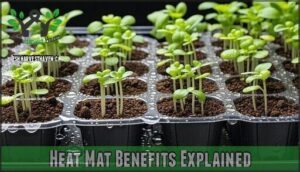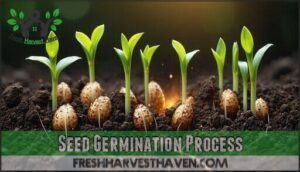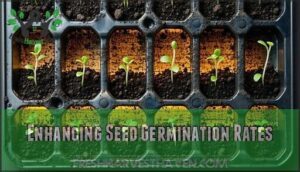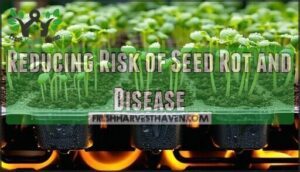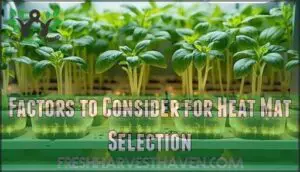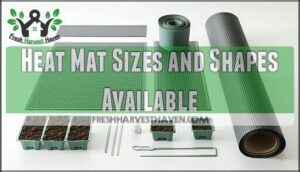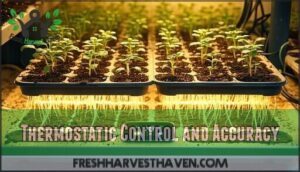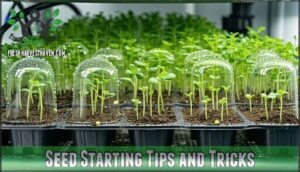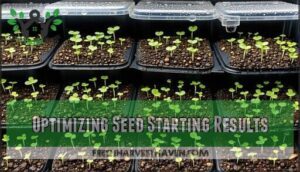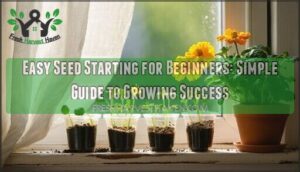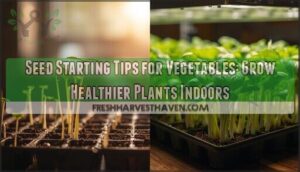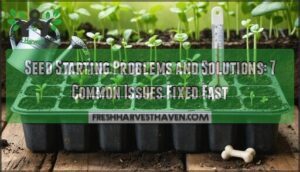This site is supported by our readers. We may earn a commission, at no cost to you, if you purchase through links.
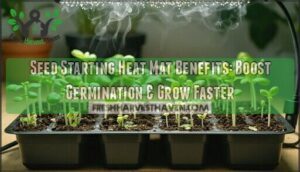
You’ll see your seeds sprout 50% quicker when heat mats warm soil 10-20°F above room temperature, creating that sweet spot of 65-75°F most seeds crave.
Heat mats prevent common problems like seed rot in cold, damp conditions while ensuring consistent germination rates.
They’re game-changers for warm-weather crops like tomatoes and peppers that won’t budge in cool soil.
Think of them as insurance against temperature swings that can sabotage your entire seed starting operation.
The consistent warmth transforms struggling seeds into thriving plants, giving you control over your growing environment regardless of weather outside.
Smart gardeners know temperature matters just as much as water and light, and that heat mats are a crucial tool for achieving healthy seedlings.
Table Of Contents
- Key Takeaways
- Seed Starting Basics
- Heat Mat Benefits Explained
- Seed Germination Process
- Seed Starting Heat Mat Uses
- Choosing Right Heat Mat
- Seed Starting Tips and Tricks
- Optimizing Seed Starting Results
- Frequently Asked Questions (FAQs)
- Are heat mats worth it for seedlings?
- How long should you keep seedlings on a heat mat?
- Are seed starter mats worth it?
- Will seeds germinate without a heating pad?
- Can heat mats damage seeds or seedlings?
- How long should heat mats run daily?
- Do all vegetable seeds need heat mats?
- Whats the ideal heat mat wattage needed?
- Can heat mats be used outdoors safely?
- Conclusion
Key Takeaways
- You’ll see 50% faster germination when heat mats warm soil 10-20°F above room temperature, creating the ideal 65-75°F range most seeds need to sprout quickly and reliably.
- You’ll prevent seed rot and disease by maintaining consistent soil temperatures that reduce harmful fungal activity by up to 50%, especially in cool, damp conditions that typically kill seedlings.
- You’ll get stronger, healthier seedlings with better root development and disease resistance, making the transplant process smoother and improving your overall garden success rates.
- You’ll have better control over your growing environment regardless of outdoor weather swings, giving you the power to start seeds earlier and extend your growing season with consistent results.
Seed Starting Basics
Starting seeds successfully depends on understanding three key factors: seed type, temperature requirements, and moisture needs.
You’ll find that different seeds have specific germination requirements, and providing the right conditions from the start sets your seedlings up for healthy, vigorous growth.
Importance of Seeds in Gardening
Seeds are gardening’s foundation, serving as your plant reproduction powerhouse and genetic diversity treasure chest.
You’re investing in tomorrow’s food source while supporting ecosystem health and economic value.
A quality seed starting heat mat transforms germination success, making heat mat benefits essential for serious gardeners.
These seed starting supplies boost seedling heat mat performance dramatically.
Types of Seeds and Their Requirements
Your garden holds potential for both Wild Seeds from nature’s untouched landscapes and Cultivated Seeds bred for specific traits.
Crop Seeds like tomatoes need different care than Ornamental Seeds for flowers.
Hybrid Seeds offer uniform growth, while open-pollinated varieties maintain genetic diversity.
Understanding these seed types helps you choose the right seed starting heat mat and supplies for ideal seed germination success.
Some plants, like spinach and arugula, exhibit excellent cool soil germination.
Seed Germination and Growth Factors
Understanding what makes seeds tick is like cracking nature’s code.
Several key factors work together to turn dormant seeds into thriving seedlings, and mastering these elements helps you achieve faster germination and stronger plants.
- Germination Temperature – Most seeds need consistent warmth between 65-85°F, which is where a garden heat mat becomes your secret weapon for temperature control
- Moisture Levels – Seeds require steady hydration without waterlogging, creating the perfect environment for seed germination to begin
- Light Exposure – Some seeds need darkness while others crave light, so understanding your specific varieties prevents germination delays
- Seed Dormancy – Breaking natural dormancy mechanisms through proper temperature and moisture triggers faster germination rates
- Nutrient Availability – Adequate soil nutrients support robust seedling growth once germination starts, setting the foundation for healthy plants
Heat Mat Benefits Explained
You’ll discover how heat mats transform your seed starting success by creating the perfect growing environment your seeds crave.
These simple tools solve the biggest challenge most gardeners face: getting seeds to sprout consistently in cool indoor conditions, which is essential for seed starting success.
Planning Site Layout
Your seed starting setup needs thoughtful planning before you plug in that garden heat mat. Smart layout decisions maximize your propagation mat’s effectiveness while creating an efficient workspace.
Understanding your region’s average first frost date is essential for timing your seed starts.
| Layout Factor | Consideration | Heat Mat Impact |
|---|---|---|
| Sunlight Exposure | South-facing windows provide 6+ hours direct light | Reduces supplemental heating needs |
| Space Allocation | Allow 12-18 inches between trays for air circulation | Prevents overheating and disease spread |
| Water Access | Position within 6 feet of water source | Maintains consistent soil moisture for soil warming |
| Accessibility Needs | Keep seedling trays at waist height | Easy monitoring of seed starting progress and faster germination |
Choosing Plant Varieties
After mapping your space, you’ll want to select varieties that match your setup and goals.
Heat mats excel at boosting germination rates for warm-season crops, making plant propagation more predictable.
Consider these factors for ideal seed selection:
- Climate Considerations – Choose varieties suited to your growing zone and season length
- Growth Habits – Match compact varieties to limited space, vining types to larger areas
- Disease Resistance – Select resistant cultivars to improve seedling success rates
- Pollination Needs – Pick self-pollinating varieties or plan for adequate cross-pollination spacing
Installing Irrigation Systems
Water becomes your greatest ally once you’ve selected varieties that thrive with heat mat assistance. Your System Design should connect directly to your Water Source, whether that’s municipal supply or rainwater collection.
PVC Pipe Materials work best for durability and easy maintenance. Consider drip irrigation with Automation Options like timers to deliver consistent moisture without overwatering.
This creates the perfect environment where consistent temperature from your heat mat combines with proper hydration for ideal root development. Many systems rely on durable PVC components for their construction.
Warm soil plus steady water equals seedling success. Set up a simple Maintenance Schedule to check connections monthly, ensuring your plant propagation setup runs smoothly all season long.
Seed Germination Process
When you start seeds indoors, temperature acts like a wake-up call that triggers the germination process and determines how quickly your seedlings emerge.
Getting the temperature right from the start sets your plants up for strong, healthy growth that’ll make your gardening efforts pay off.
Role of Temperature in Seed Germination
Temperature acts like your seeds’ wake-up call.
Temperature triggers the spark that transforms dormant seeds into thriving plants.
When soil reaches the right warmth, enzymes activate and kickstart the seed germination process.
Without consistent temperature from a heat mat, seeds stay dormant or germinate poorly.
Warm soil speeds up germination rate and promotes healthy root development, while cold conditions invite rot and disease that kill seedlings before they start, affecting their ability to reach optimal root development.
Optimal Temperature Ranges for Seeds
Getting the right germination temperature for your seeds makes all the difference between success and frustration.
Different species have vastly different temperature needs, and understanding these requirements will dramatically improve your seedling vigor and germination rate.
- Warm-season crops like tomatoes and peppers need 75-90°F soil temperature for ideal sprouting
- Cool-season vegetables such as lettuce and spinach prefer 50-75°F for best results
- Heat mats can raise soil temperature by 10-20°F above room temperature consistently
- Species variation means checking specific requirements prevents disappointing germination failures
Maintaining Consistent Temperature
Your heat mat placement directly affects how well you maintain that ideal temperature throughout the seed germination process.
Position your mat on a flat, insulated surface to prevent heat loss.
Temperature monitoring becomes simple with a digital thermometer placed at seedling level. Check readings twice daily to guarantee consistent warmth.
A heat mat thermostat helps regulate temperature.
Insulation methods like covering trays with plastic domes help trap heat around your seedling. This seedling protection creates the perfect microclimate for healthy seedling care and faster growth.
Seed Starting Heat Mat Uses
Heat mats transform your seed starting game by creating the warm soil conditions seeds crave for faster, more reliable germination.
You’ll see dramatically improved success rates as the consistent bottom heat encourages seeds to sprout quickly while protecting them from temperature swings that can kill germination.
Enhancing Seed Germination Rates
Heat mats transform your seed starting game by cranking up germination rates dramatically. You’ll see seeds pop faster when Temperature Consistency meets their specific needs.
Here’s how heat mats boost your success:
- Seed Viability increases by 15-30% with proper soil warming
- Moisture Levels stay balanced as warm soil retains water better
- Cold-sensitive varieties germinate in half the normal time
- Soil Composition activates beneficial microbes faster
- Seedling Establishment happens quicker with ideal root zone heat
Your seed germination process depends heavily on seed germination requirements being met consistently.
Improving Seedling Growth and Health
Beyond improving seed germination, you’ll discover that seedlings grown with heat mats develop stronger root systems and enhanced nutrient uptake.
Consistent warmth promotes robust root development, which directly impacts seedling health and growth rates.
To guarantee the best results, consider using a quality seed starting mix for ideal drainage.
Your seedlings will show better disease resistance and vigor, making the hardening off process smoother when it’s time to transplant outdoors, resulting in overall better disease resistance and a more successful transplant with enhanced nutrient uptake.
Reducing Risk of Seed Rot and Disease
You’ll protect your seedlings from harmful fungi when heat mats maintain ideal soil temperatures.
Cool, wet conditions invite damping-off disease and root rot, but consistent warmth reduces pathogen activity by up to 50%.
Heat mats speed germination, shortening exposure to soil-borne threats, and this natural seedling protection method cuts fungicide use.
This method promotes stronger seedling health through better root development and improved watering practices.
Choosing Right Heat Mat
Selecting the right heat mat isn’t just about grabbing the first one you see – it’s about matching your specific needs with the right features.
You’ll want to take into account factors like mat size, temperature control options, and whether you need multiple zones for different seed types, which involves considering complete concepts.
Factors to Consider for Heat Mat Selection
Looking beyond the basic uses of heat mats, you’ll need to evaluate several key factors to find the perfect match for your seedling production needs.
The right choice makes all the difference between struggling seedlings and thriving plants. A key aspect is guaranteeing consistent warmth for best growth.
Consider these factors when selecting your heat mat:
- Mat Size – Choose dimensions that match your seed trays and growing space requirements
- Thermostat Accuracy – Look for digital controllers with precise temperature monitoring for best seedling temperature control
- Energy Consumption – Select low-wattage models (15-25W) to keep operating costs reasonable during extended use
- Safety Features – Prioritize waterproof construction and overheat protection for worry-free seedling care
- Mat Durability – Invest in five-layer construction with UL certification to ensure years of reliable seedling growth support
Heat Mat Sizes and Shapes Available
Once you’ve settled on features, Standard Mat Sizes come in 10"x20", 20"x20", and 48"x20" options.
These match common Propagation Tray Fit dimensions perfectly. Custom Heat Mats work for unique setups.
Consider your Seedling Tray Capacity needs – larger operations need wider mats for multiple trays. Understanding the available heat mat sizes is essential for efficient seed starting.
Geometric Heat Distribution varies by shape, affecting uniform seedling development across your growing space.
| Size | Best For | Coverage |
|---|---|---|
| 10"x20" | Single seed tray | 20-50 seedlings |
| 20"x20" | Multiple small trays | 100-200 seedlings |
| 48"x20" | Commercial production | 400+ seedlings |
Thermostatic Control and Accuracy
Temperature stability makes all the difference when you’re chasing perfect seedling heat.
Digital thermostats trump analog versions with precise accurate settings that won’t drift over time.
Proper sensor placement near your seeds guarantees thermostat calibration stays on target.
You’ll get consistent plant growth when your heat mat maintains steady seedling temperature within one degree.
This precision prevents the hot-and-cold rollercoaster that stunts seed germination and weakens developing seedlings, ensuring temperature stability and promoting consistent plant growth.
Seed Starting Tips and Tricks
Once you’ve got your heat mat working, you’ll need to master a few other critical factors to turn seeds into healthy seedlings.
Getting the soil moisture, lighting, and air circulation right can make the difference between strong plants and weak ones that struggle to survive.
Soil and Moisture Management
Your heat mat’s working perfectly, but poor soil moisture can still torpedo seed germination.
Mix quality potting soil with perlite for proper drainage solutions. Check soil composition by sticking your finger one inch deep—if it’s dry, it’s watering time.
Maintain consistent seedling humidity around 60-70% and avoid overwatering, which creates soggy conditions that kill more seeds than drought ever will, emphasizing the importance of proper moisture control.
Light and Ventilation Requirements
Beyond proper soil and moisture, your seedlings need adequate light and fresh air to thrive. Without these elements, even perfectly heated seeds will struggle.
Here’s what your seedlings require for healthy development:
- Light intensity of 2000-3000 foot-candles using LED grow lights positioned 6-12 inches above plants
- Photoperiod control providing 14-16 hours of daily illumination for most vegetable seedlings
- Ventilation methods like small fans creating gentle air movement to prevent fungal issues
- Air circulation that strengthens stems and reduces seedling etiolation (stretching toward light)
- Seedling care monitoring that combines proper seedling light, seedling temperature, seedling air circulation, and seedling humidity
Good airflow prevents damping-off disease while proper lighting stops leggy growth.
Common Mistakes to Avoid in Seed Starting
Overwatering kills more seedlings than drought ever will.
Poor Lighting creates weak, stretchy plants that topple over.
Wrong Soil invites diseases and stunts growth.
Crowded Seeds compete fiercely, leaving you with wimpy plants.
Late Planting rushes everything, compromising seedling care.
Focus on proper seedling watering, adequate seedling light, and giving each plant breathing room for ideal seedling nutrition and seedling protection.
Optimizing Seed Starting Results
Once you’ve got your seeds germinating with heat mats, you need to monitor their progress closely to guarantee strong, healthy seedlings.
The key to successful seed starting lies in maintaining consistent conditions while gradually preparing your young plants for transplanting into the garden, which is crucial for healthy seedlings.
Monitoring Temperature and Humidity
Keep tabs on your seedlings’ key stats like a detective tracking clues. Proper sensor placement and data logging help you maintain ideal ranges for seedling temperature and humidity, ensuring prime seedling growth and protection.
Adequate light is also essential for preventing leggy growth, as seen in the guide to Adequate light.
To achieve this, consider the following tools:
- Digital thermometers with remote monitoring capabilities placed at seedling level
- Hygrometers positioned away from direct heat sources for accurate humidity readings
- Data logging systems that track temperature fluctuations over 24-hour periods
- Alarm systems that alert you when conditions drift outside ideal ranges
- Multiple sensors across your setup to identify microclimatic variations and ensure accurate humidity readings for the best results in seedling temperature control.
Providing Optimal Care for Seedlings
Once your seedlings emerge, they’ll need consistent care to thrive.
Water gently using bottom-up watering techniques to prevent root disturbance.
Monitor seedling nutrition needs – young plants typically don’t require fertilizer for the first few weeks.
Maintain proper seedling light exposure with 12-16 hours daily.
Control seedling temperature around 65-70°F and seedling humidity at 50-60%.
Begin hardening off gradually and watch for pest control issues like aphids or fungus gnats for effective disease prevention.
Transplanting Seedlings Successfully
Once your seedlings show strong growth, prepare for the big move outdoors.
Successful seedling transplanting requires careful planning and gentle handling to prevent root shock and support healthy seedling establishment.
- Hardening Off Process: Gradually expose seedlings to outdoor conditions over 7-10 days, starting with 1-2 hours of filtered sunlight and increasing daily exposure while monitoring for stress signs.
- Soil Prep and Timing: Prepare transplant beds with loose, well-draining soil and wait until soil temperatures match your seedlings’ preferred range – typically 60-70°F for most vegetables.
- Gentle Handling Techniques: Water seedlings before transplanting, handle by leaves rather than stems, and maintain consistent watering schedule post-transplant to support seedling care during this critical period of development.
Frequently Asked Questions (FAQs)
Are heat mats worth it for seedlings?
Heat mats boost germination rates by warming soil to ideal temperatures, especially for warm-season crops like tomatoes and peppers. They’re worth it if you’re starting seeds indoors early.
How long should you keep seedlings on a heat mat?
Most seedlings need the heat mat for 2-3 weeks until they’ve developed their first true leaves.
You’ll know it’s time to wean them off when they’re established and growing steadily at room temperature.
Are seed starter mats worth it?
You’ll get better germination rates and faster sprouting with heat mats.
They’re particularly valuable for warm-season crops like tomatoes and peppers, providing consistent soil temperature that’s hard to maintain naturally indoors, which improves germination rates.
Will seeds germinate without a heating pad?
Most seeds germinate at 65-75°F, but you can succeed without heating pads.
Room temperature works for many varieties, though germination takes longer.
Cool-season crops like lettuce actually prefer cooler conditions for sprouting.
Can heat mats damage seeds or seedlings?
Yes, you can definitely damage seeds and seedlings with heat mats if they’re too hot or used incorrectly.
Excessive heat kills seeds, while overheating seedlings causes wilting, root damage, and stunted growth.
Monitor temperatures carefully.
How long should heat mats run daily?
Continuous operation burns 15% more electricity than timer-controlled heating. You’ll want to run your heat mats constantly during germination, then switch to 12-16 hour cycles once seedlings emerge to prevent overheating.
Do all vegetable seeds need heat mats?
Not all vegetable seeds require heat mats.
Cool-season crops like lettuce, peas, and spinach germinate well at room temperature.
However, warm-season vegetables such as tomatoes, peppers, and eggplants benefit substantially from the consistent warmth heat mats provide.
Whats the ideal heat mat wattage needed?
Most gardeners overlook this: heat mats consume 10-20 watts per square foot.
You’ll need 15-25 watts for standard seed trays, providing consistent 70-80°F soil temperature for ideal germination without energy waste.
Can heat mats be used outdoors safely?
Heat mats can work outdoors, but you’ll need weatherproof models with GFCI protection. Standard indoor mats aren’t built for moisture and temperature swings that’ll damage them quickly.
Conclusion
Studies show that seeds germinated with heat mats emerge 50% faster than those without controlled temperature.
You’ve learned how seed starting heat mat benefits transform your gardening success through consistent warmth and improved germination rates. These tools eliminate guesswork from temperature control, prevent seed rot, and boost seedling health.
Your investment in a quality heat mat with thermostat control pays dividends in stronger plants and higher success rates. Start using one this season for remarkable results.
- https://growerssolution.com/blogs/growers-learning-center/heat-mats-what-are-the-benefits
- https://shop.epicgardening.com/products/seed-starting-heat-mat
- https://www.greenhousemegastore.com/collections/heat-mats-cables
- https://harvesttotable.com/seedling-heat-mat-buyers-guide/
- https://www.lovethatleaf.co.nz/blogs/plant-care-guides/ultimate-guide-using-seedling-heat-mats-mistakes

